1993 CHEVROLET CAVALIER maintenance
[x] Cancel search: maintenancePage 217 of 308
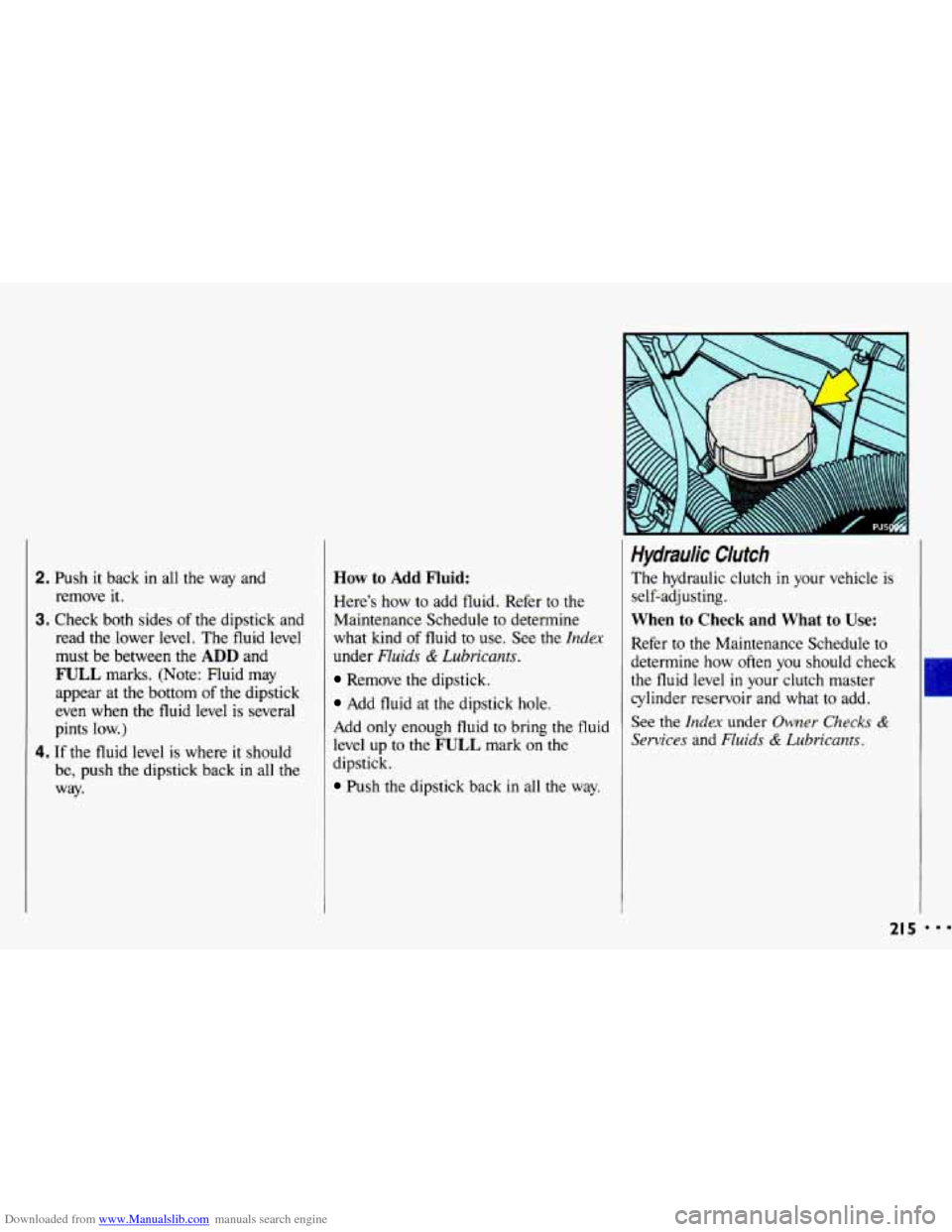
Downloaded from www.Manualslib.com manuals search engine 2. Push it back in all the way and
remove it.
3. Check both sides of the dipstick and
read the lower level. The fluid level
must be between the
ADD and
FULL marks. (Note: Fluid may
appear at the bottom of the dipstick
even when the fluid level
is several
pints low.)
4. If the fluid level is where it should
be, push the dipstick back
in all the
way.
How to Add Fluid:
Here’s how to add fluid. Refer to the
Maintenance Schedule to determine
what kind
of fluid to use. See the Index
under Fluids & Lubricants.
Remove the dipstick.
Add fluid at the dipstick hole.
Add only enough fluid to bring the fluid
level up to the
FULL mark on the
dipstick.
Push the dipstick back in all the way.
Hydraulic Clutch
The hydraulic clutch in your vehicle is
self-adjusting.
When to Check and What to Use:
Refer to the Maintenance Schedule to
determine how often you should check
the fluid level
in your clutch master
cylinder reservoir and what
to add.
See the
Index under Owner Checks &
Services and Fluids & Lubricants.
I
21 5 ...
Page 222 of 308
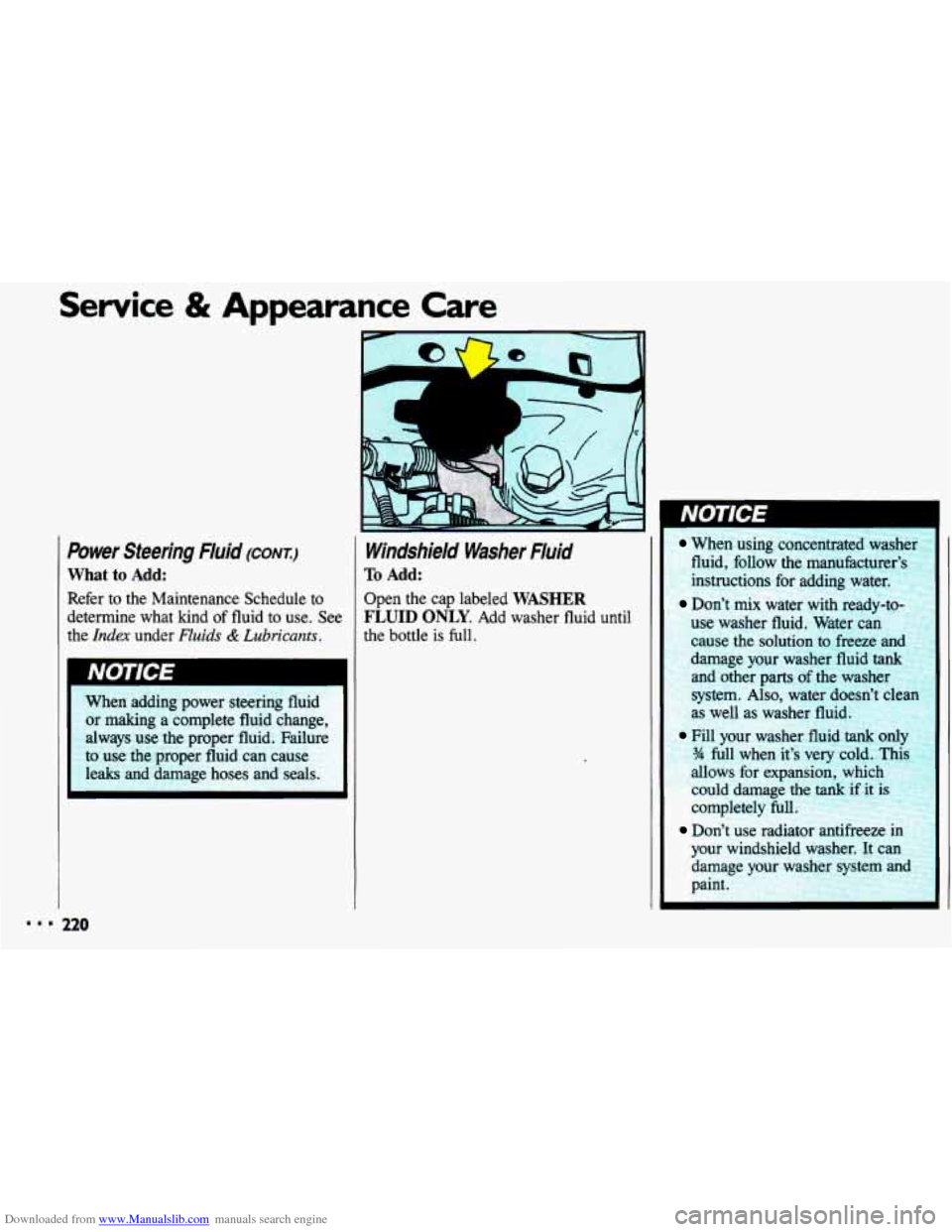
Downloaded from www.Manualslib.com manuals search engine ..I
Service & Appearance Care
Power Steering Fluid (CONT.)
What to Add:
Refer to the Maintenance Schedule to determine what kind of fluid to use. See
the
Index under Fluids & Lubricants.
When adding power steering fluid
or making a complete fluid change,
always use the proper fluid. Failure
to use the proper fluid can cause
leaks and damage hoses and seals.
120
Windshield Washer Fluid
To Add:
Open the cap labeled WASHER
FLUID ONLY. Add washer fluid until
the bottle is full.
When using concentrated washer
fluid, follow the manufacturer’s
instructions for adding water.
Don’t mix water with ready-to-
l15e washer fluid. Water can
use the solution
to freeze and
. .tmage your washer fluid tank
and other parts of the washer
system.
Also, water doesn’t clean
s well as washer fluid.
Fill your washer fluid tank on14
?4 full when it’s very cold. Thir
allows for expansion, which
could damage the
tank if it is
completely
full
Don’t use radiator antifreeze
your windshield washer.
It can
damage your washer system an(
paint.
Page 233 of 308
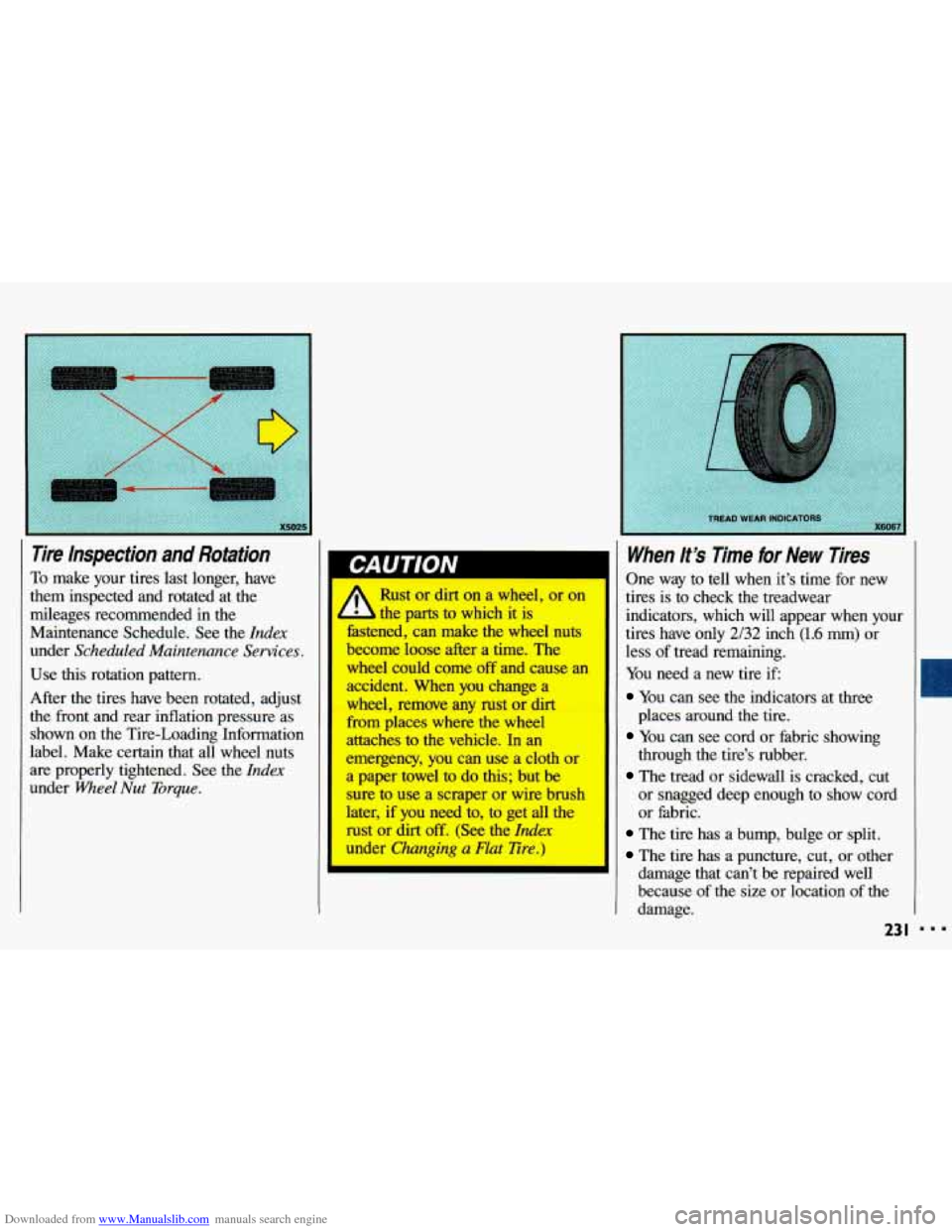
Downloaded from www.Manualslib.com manuals search engine Tire hspection and Rotation I
Use this rotation pattern.
After the tires have been rotated, adjust
the front and rear inflation pressure as
shown on the Tire-Loading Information
label. Make certain that all wheel nuts
are properly tightened. See the Index
under Wheel Nut Torque.
To make your tires last longer, have
them inspected and rotated at the
mileages recommended in the
Maintenance Schedule. See the
Index
under Scheduled Maintenance Services.
u I I’ -
Rust or dirt on a wheel, or on
; parts to which it is
fastened, can make the wheel nuts
become loose after a time. The
wheel could come off and cause an
accident. When you change a
wheel, remove any rust or dirt
from
places where the wheel
attaches to the vehicle. In an
emergency, you can use a cloth or
a paper towel to do this; but be
sure to use a scraper or wire brush
later, if you need to, to get all the
rust or dirt
off. (See the Index
under Changing a Flat Tire.)
When lt’s Time for New Tires
One way to tell when it’s time for new
tires
is to check the treadwear
indicators, which will appear when your
tires have
only 2/32 inch (1.6 mm) or
less of tread remaining.
You need a new tire if
You can see the indicators at three
You can see cord or fabric showing
The tread or sidewall is cracked, cut
places around the tire.
through the tire’s rubber.
or
snagged deep enough to show cord
or fabric.
The tire has a bump, bulge or split.
The tire has a puncture, cut, or other
damage that can’t be repaired well
because
of the size or location of the
damage.
23 I
Page 247 of 308
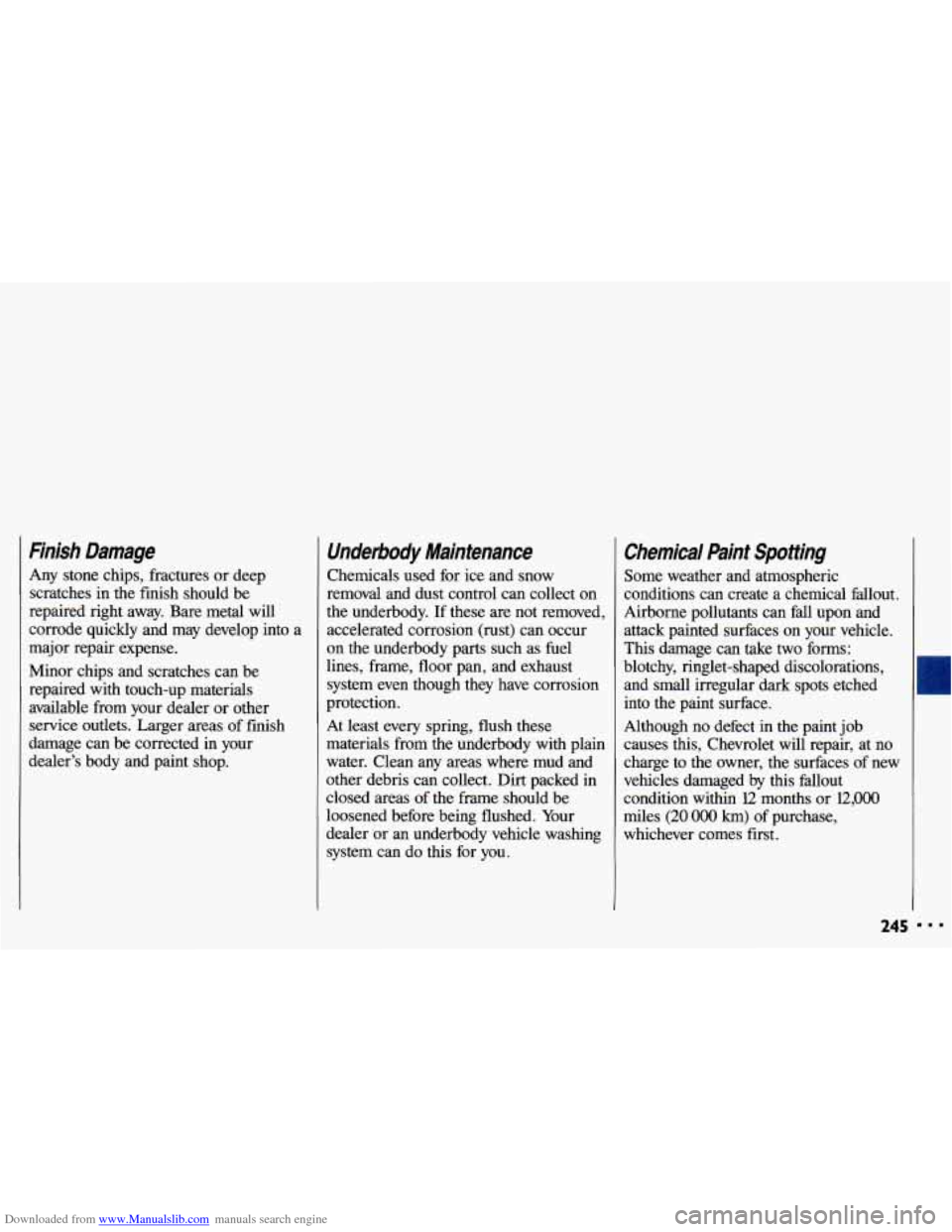
Downloaded from www.Manualslib.com manuals search engine Finish Damage
Any stone chips, fractures or deep
scratches
in the finish should be
repaired right away. Bare metal will
corrode quickly and may develop into a
major repair expense.
Minor chips and scratches can be
repaired with touch-up materials
available from your dealer or other
service outlets. Larger areas of finish
damage can be corrected in your
dealer’s body and paint shop.
Underbody Maintenance
Chemicals used for ice and snow
removal and dust control can collect on
the underbody. If these are not removed,
accelerated corrosion (rust) can occur
on the underbody parts such as fuel
lines, frame, floor pan, and exhaust
system even though they have corrosion
protection.
At least every spring, flush these
materials from the underbody with plain
water. Clean any areas where mud and
other debris can collect. Dirt packed in
closed areas
of the frame should be
loosened before being flushed. Your
dealer or an underbody vehicle washing
system can do this for you.
Chemical Paint Spotting
Some weather and atmospheric
conditions can create a chemical fallout.
Airborne pollutants can fall upon and
attack painted surfaces on your vehicle.
This damage can take two forms:
blotchy, ringlet-shaped discolorations, and small irregular dark spots etched
into the paint surface.
Although no defect in the paint job
causes this, Chevrolet will repair, at no
charge to the owner, the surfaces of new
vehicles damaged by this fallout
condition within
l2 months or l2,OOO
miles (20 000 km) of purchase,
whichever comes first.
245 I
Page 258 of 308

Downloaded from www.Manualslib.com manuals search engine Service & Appearance Care
Normal Maintenance Replacement Parts
Air Cleaner Element
2.2L L4 . . . . , . . . . . . . . . . . . . . . . . . AC Type A-1172C
3.1L
V6 . . . . . . . . . . . . . . . . . . . . . . . . AC Type A-1098C
2-24
. . . . . . . . . . . . . . . . . . . . . . . . AC Type A-925C
Engine Oil Filter
2.2L L4 . . . . . . . . . . . . . . . . . . . . . . AC Type PF-47
3.1L
V6 . . . . . . . . . . . . . . . . . . . . . . . . AC Type PF-51
2.2L L4
. . . . . . . . . . . . . . . . . . . . . . . AC Type CV-9OOC
3.1L V6
. . . . . . . . . . . . . . . . . . . . . . . . AC Type CV-892C
2.2L
L4 . . . . . . . . . . . . . . . . . . . . . . . AC Type eR44LTSMA
3.1L V6
. . . . . . . . . . . . . . , . . . . . . . . . AC Type eR44LTSM
PCV Valve
Spark Plugs
Gap: 1.14 mm (0.045 inch)
Gap: 1.14
mm (0.045 inch)
. . . 256
Page 261 of 308
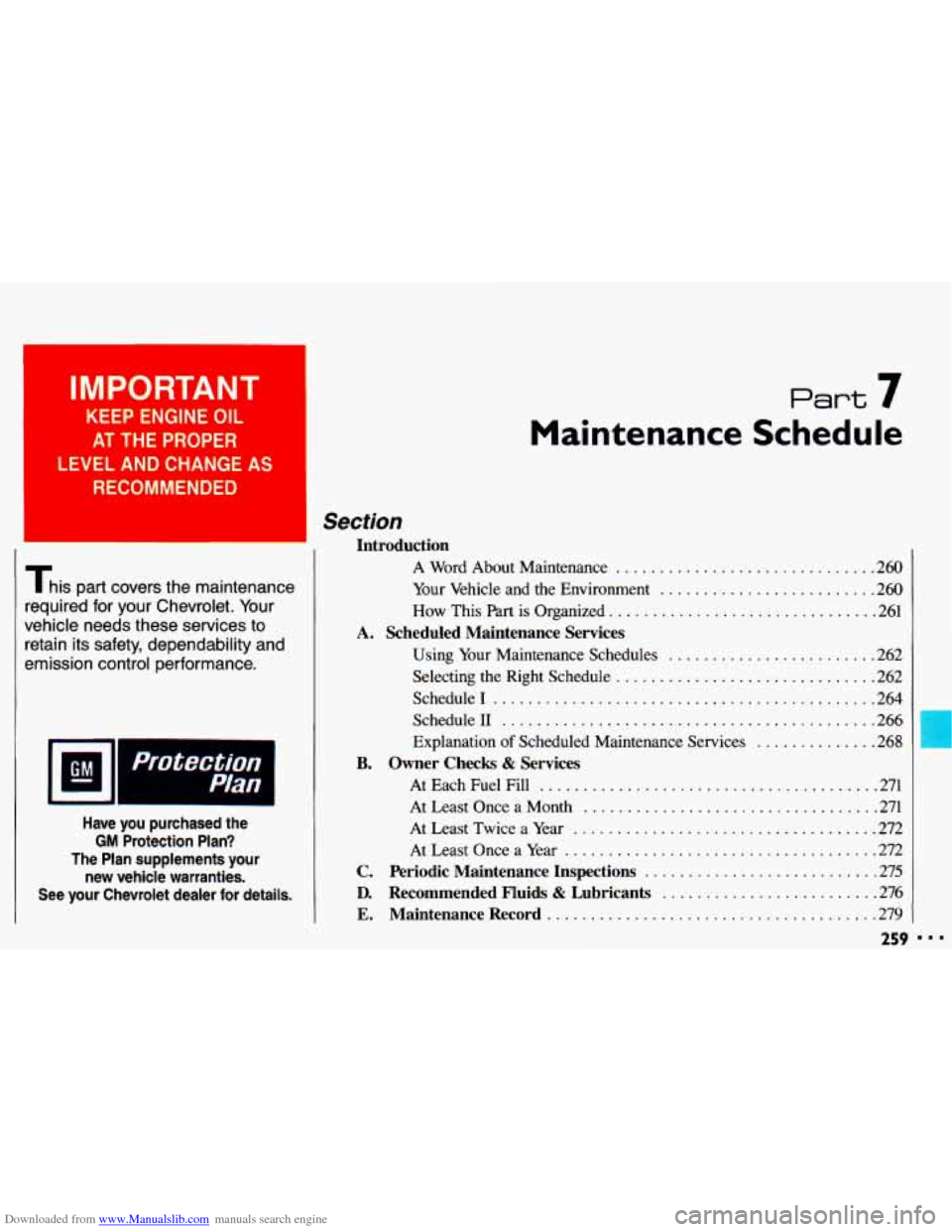
Downloaded from www.Manualslib.com manuals search engine I IMPORTANT
KEEP ENGINE OIL
AT THE PROPER
LEVEL AND CHANGE AS
RECOMMENDED
This part covers the maintenance
required for your Chevrolet. Your
vehicle needs these services to
retain its safety, dependability and
emission control performance.
Pian I
Section
Part 7
Maintenance Schedule
Have you purchased the
GM Protection Plan?
The Plan supplements your new vehicle warranties.
See your Chevrolet dealer for details.
Introduction
A Word About Maintenance . . . . . . . . . . . . . . . . . . . . . . . . . . . . . .260
Your Vehicle and the Environment
. . . . . . . . . . . . . . . . . . . . . . . , .260
How This
Part is Organized . . . . . . . . . . . . . . . . . . . . . . . . . . . . . . .261
Using Your Maintenance Schedules
. . . . . . . . . . . . . . . . . . . . . . . .262
Selecting the Right Schedule
. . . . . . . . . . . . . . . . . . . . . . . . . . . . . .262
Schedule1
............................................ 264
Schedule11
........................................... 266
Explanation of Scheduled Maintenance Services . . . . . . . . . . . . . .268
AtEachFuelFill
....................................... 271
AtLeastOnceaMonth
.................................. 271
At Least Twice a Year
. . . . . . . . . . . . . . . . . . . . . , . , . . . . . . . . . . .272
At Least Once a Year
. . . . . . . . . . . . . . . . . . . . . . . . . . . . . . . . . . . .272
C. Periodic Maintenance Inspections . . . . . . . . . . . . . . . . . . . . . . . . . . .275
D. Recommended Fluids & Lubricants . . . . . . . . . . . . . . . . . . . . . . . . .276
E. MaintenanceRecord ...................................... 279
A. Scheduled Maintenance Services
B. Owner Checks & Services
259 888
Page 262 of 308
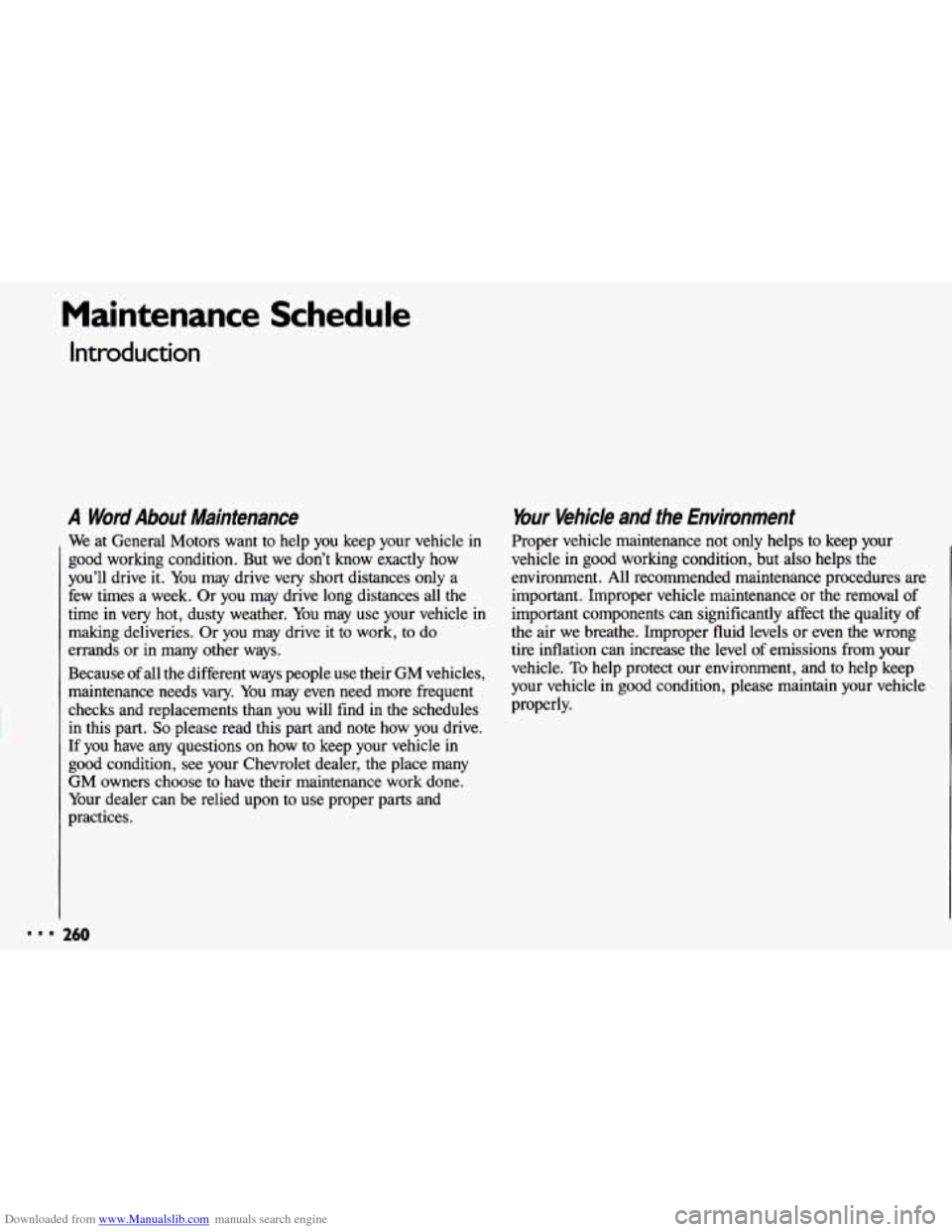
Downloaded from www.Manualslib.com manuals search engine Maintenance Schedule
Introduction
A Word About Maintenance
We at General Motors want to help you keep your vehicle in
good working condition. But
we don’t know exactly how
you’ll drive it. You may drive very
short distances only a
few times a week. Or
you may drive long distances all the
time in very hot, dusty weather.
You may use your vehicle in
making deliveries.
Or you may drive it to work, to do
errands or in many other ways.
Because of all the different ways people use their GM vehicles,
maintenance needs vary. You may even need more frequent
checks and replacements than you will find in the schedules
in this part.
So please read this part and note how you drive.
If you have
any questions on how to keep your vehicle in
good condition, see your Chevrolet dealer, the place many
GM owners choose to have their maintenance work done.
Your dealer can be relied upon to use proper parts and
practices.
260
Your Vehicle and the Environment
Proper vehicle maintenance not only helps to keep your
vehicle in good working condition, but also helps the
environment. All recommended maintenance procedures are
important. Improper vehicle maintenance or the removal
of
important components can significantly affect the quality of
the air we breathe. Improper fluid levels or even the wrong
tire inflation can increase the level
of emissions from your
vehicle.
To help protect our environment, and to help keep
your vehicle in
good condition, please maintain your vehicle
properly.
Page 263 of 308
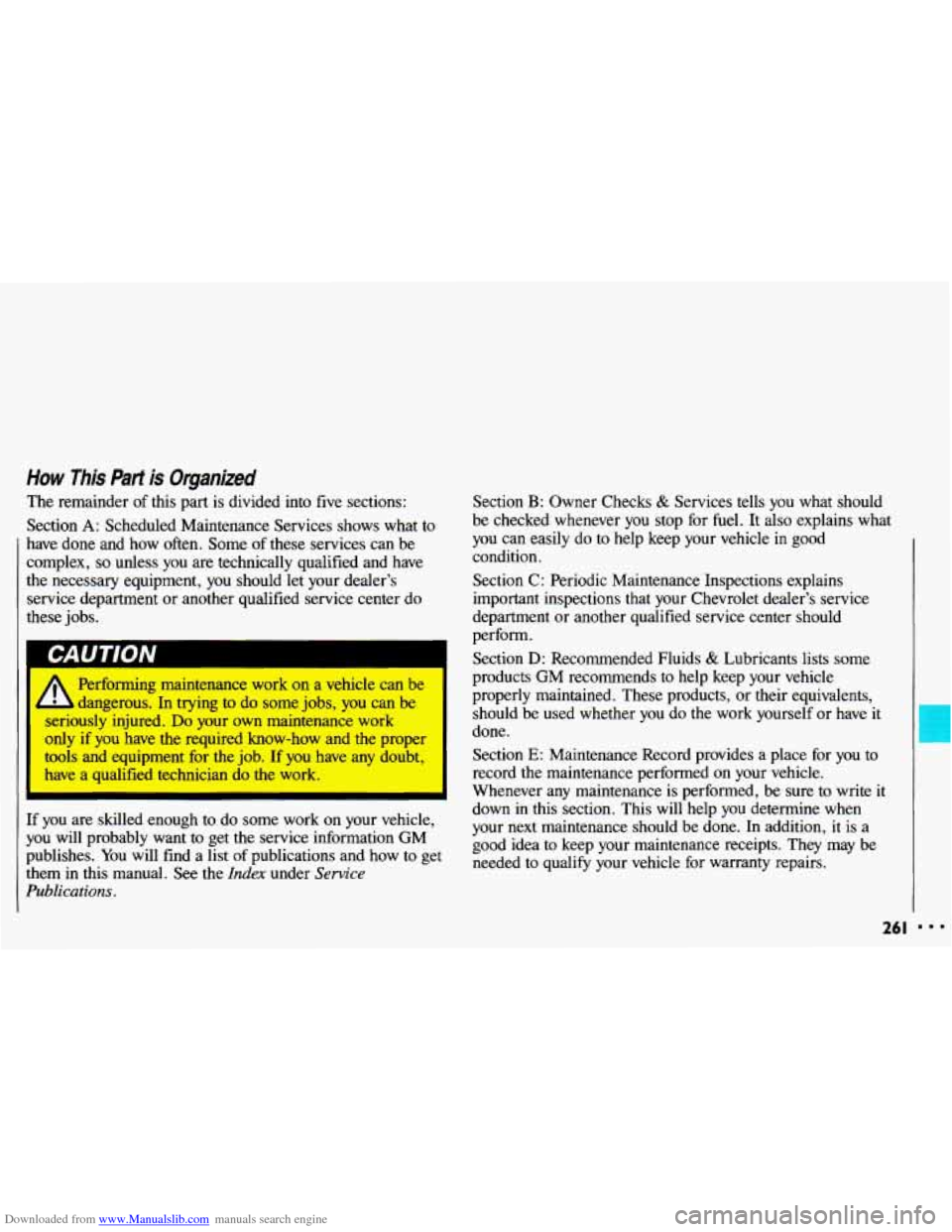
Downloaded from www.Manualslib.com manuals search engine How This Part is Organized
The remainder of this part is divided into five sections:
Section
A: Scheduled Maintenance Services shows what to
have done and how often. Some
of these services can be
complex,
so unless you are technically qualified and have
the necessary equipment, you should let your dealer’s
service department
or another qualified service center do
these jobs.
Performing maintenance work
on a vehicle can be
dangerous. In trying to do some jobs, you can be
seriously injured. Do your own maintenance work
only if you have the required know-how and the proper
tools and equipment for the job.
If you have any doubt,
have
a qualified technician do the work.
If you are skilled enough to do some work on your vehicle,
you will probably want to get the service information GM
publishes. You
will find a list of publications and how to get
them in this manual.
See the Index under Service
Publications.
Section B: Owner Checks & Services tells you what should
be checked whenever
you stop for fuel. It also explains what
you can easily do to help keep your vehicle
in good
condition.
Section
C: Periodic Maintenance Inspections explains
important inspections that your Chevrolet dealer’s service
department or another qualified service center should
perform.
Section
D: Recommended Fluids & Lubricants lists some
products GM recommends to help keep your vehicle
properly maintained. These products, or their equivalents,
should be used whether you do the work yourself or have it
done.
Section
E: Maintenance Record provides a place for you to
record the maintenance performed on your vehicle.
Whenever
any maintenance is performed, be sure to write it
down in this section. This
will help you determine when
your next maintenance should be done. In addition,
it is a
good idea to keep your maintenance receipts. They may be
needed to qualify your vehicle for warranty repairs.
26 I